 | |
 |
Haeju Stadium is a multi-use stadium in Haeju, North Korea. It is currently used mostly for football matches. The stadium holds 25,000 spectators. [1]
 | |
 |
Haeju Stadium is a multi-use stadium in Haeju, North Korea. It is currently used mostly for football matches. The stadium holds 25,000 spectators. [1]

Pyeonghwa Motors, a Korean language word for "peace", also spelled Pyonghwa, is one of the two car manufacturers and dealers in the North Korean automotive industry, alongside Sungri Motor Plant. Until 2013, it was a joint venture in Nampo between Pyonghwa Motors of Seoul, a company owned by Sun Myung Moon's Unification Church, and the North Korean Ryonbong General Corp. The joint venture produced small cars under licence from Fiat and Brilliance China Auto, a pickup truck and an SUV using complete knock down kits from Chinese manufacturer Dandong Shuguang, and a luxury car of SsangYong design. From 2013, the company has been fully owned by the North Korean state.
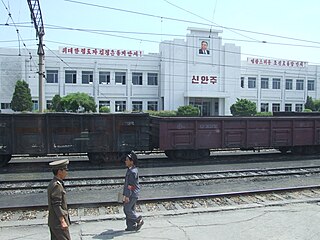
Sinanju is a region (신안주) in Anju city, South Pyongan Province, North Korea. The name literally means "Comfortable New Village." When Anju County was raised to the status of a city in August 1987, Sinanju Workers' District was divided into Sinwon-dong, Wonhung-dong, Yokchon-dong.

The Nyongbyon Nuclear Scientific Research Center (녕변원자력연구소) is North Korea's major nuclear facility, operating its first nuclear reactors. It is located in Nyongbyon County in North Pyongan Province, about 100 km north of Pyongyang. The center produced the fissile material for North Korea's six nuclear weapon tests from 2006 to 2017, and since 2009 is developing indigenous light water reactor nuclear power station technology.

Haeju is a city located in South Hwanghae Province near Haeju Bay in North Korea. It is the administrative centre of South Hwanghae Province. As of 2008, the population of the city is estimated to be 273,300. At the beginning of the 20th century, it became a strategic port in Sino-Korean trade. Haeju has chemical-related enterprises and a cement factory.

Pyongsong is a city in North Korea, the capital city of South Pyongan province in western North Korea. The city is located about 32 kilometres northeast of Pyongyang, and was formally established in December 1969. It has a population of 284,386.
Haeju Airport is an airport located in Haeju, South Hwanghae, North Korea. Haeju Airport is controlled by the Korean People's Army. The airport mainly operates military flights but also has a limited number of civilian flights. This airport is notorious to South Korean intelligence authorities, because former North Korean Intelligence agents frequently use it as a transfer point. The single runway 12/30 is 6562x289 ft.
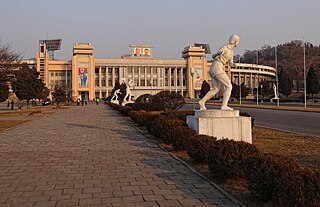
Kim Il Sung Stadium (Korean: 김일성경기장) is a multi-purpose stadium located in Pyongyang, the capital city of North Korea. The stadium is used primarily for association football matches.

Sunch'ŏn is a city in South Pyongan province, North Korea. It has a population of 297,317, and is home to various manufacturing plants. The city is on the Taedong River.
Nampo Stadium is a multi-purpose stadium in Nampo, North Korea. It is currently used mostly for football matches. The stadium holds 30,000 people and opened in June 1973. The stadium was renovated in 2004, and in 2017

Ryugyong Chung Ju-yung Gymnasium is an indoor sporting arena located in Pyongyang, North Korea. The capacity of the arena is 12,309 and it was built in 2003. It is used to host indoor sporting events, such as basketball and volleyball as well as concerts and art performances.

Chandongja Park is a multi-use stadium in Chongjin, North Korea. It is currently used mostly for football matches and hosts the home matches of Ch'ŏngjin Chandongcha. The stadium holds 15,000 spectators.
The Sinuiju Stadium (신의주경기장), also known as October Stadium, is a multi-purpose stadium in Sinŭiju, North Korea, that is mainly used for events and football matches of the Amrokkang Sports Club. Built in 1965, it has a capacity of 17,500 spectators.
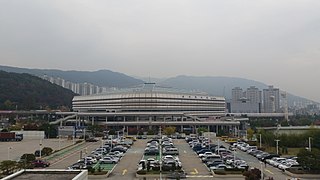
Sŏsan Stadium (Korean: 서산축구경기장) is a football stadium in Pyongyang, North Korea. It is currently used mostly for football matches. The stadium holds 25,000 people, and was built by the North Korean army in 1988 for the 13th World Festival of Youth and Students. It lies next to Ryanggang Hotel which was completed around the same time in 1989.
Sariwon Youth Stadium(사리원청년경기장) is a multi-purpose stadium in Sariwon, North Korea. It is currently used mostly for football matches. The stadium holds 35,000 spectators and opened in 1981.
Hamhung Stadium(함흥경기장) is a multi-purpose stadium in Hamhung, North Korea. It is currently used mostly for football matches. The stadium holds 35,000 spectators and opened in 1981.

East Pyongyang Stadium(동평양경기장) is a multi-purpose stadium in Pyongyang, North Korea. It is currently used mostly for football matches. The stadium holds 30,000 spectators and opened in 1960.
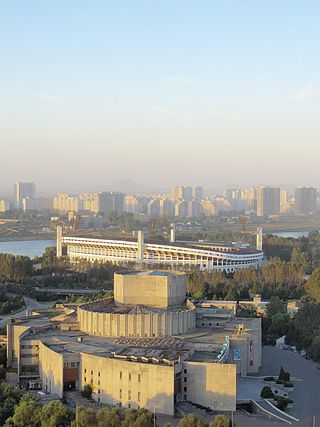
The International Cinema Hall (Korean: 평양국제영화회관) is a cinema located in North Korea. It holds the Pyongyang International Film Festival.
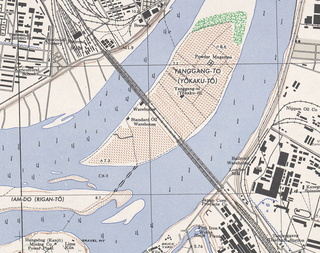
Yanggakdo, or Yanggak Island is a small island in the Taedong River, located about two kilometers to the south-east of the centre of the North Korean capital city Pyongyang. It is connected to the northern and southern side of Pyongyang by the Yanggak Bridge, which spans the island and separates it into a northeastern and southwestern part. The name means "Rams horn island" and is said to be derived from its shape.

The Puyong Hall is a historic structure located in Puyong-dong, Haeju, North Korea. The gable-roof pavilion features railings around the perimeter. It stands in a lotus pond, supported by stone pillars. First built in 1500, it was located in front of the Yong Gate. In 1526, it was expanded into the pond. The structure was destroyed during the Korean War, but later rebuilt by the ruling party Korean Workers' Party.
38°02′03″N125°43′09″E / 38.034048°N 125.719074°E